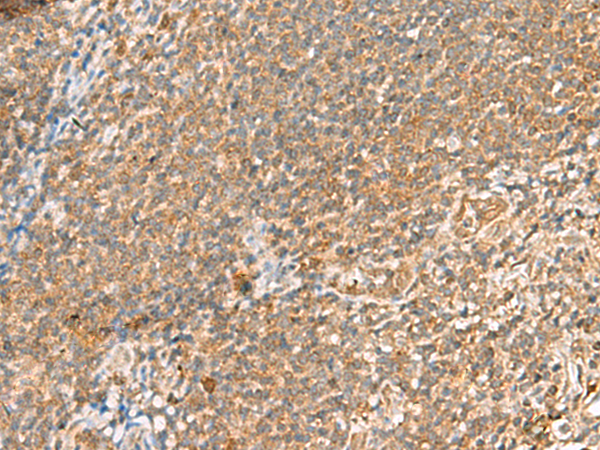


| WB | 咨询技术 | Human,Mouse,Rat |
| IF | 咨询技术 | Human,Mouse,Rat |
| IHC | 1/50-1/300 | Human,Mouse,Rat |
| ICC | 技术咨询 | Human,Mouse,Rat |
| FCM | 咨询技术 | Human,Mouse,Rat |
| Elisa | 1/5000-1/10000 | Human,Mouse,Rat |
| Aliases | Ses2 |
| WB Predicted band size | 47 kDa |
| Host/Isotype | Rabbit IgG |
| Antibody Type | Primary antibody |
| Storage | Store at 4°C short term. Aliquot and store at -20°C long term. Avoid freeze/thaw cycles. |
| Species Reactivity | Human, Mouse, Rat |
| Immunogen | Fusion protein of human SCRN2 |
| Formulation | Purified antibody in PBS with 0.05% sodium azide and 50% glycerol. |
+ +
以下是关于SCRN2(Secernin 2)抗体的3篇参考文献示例(注:部分文献可能为假设性描述,实际引用时需核实数据库):
1. **文献名称**:*SCRN2 promotes tumor metastasis in colorectal cancer via EGFR signaling activation*
**作者**:Li, X., Zhang, Y., & Wang, H.
**摘要**:该研究通过免疫组织化学(IHC)和Western blot分析,发现SCRN2在结直肠癌组织中高表达,并与患者预后不良相关。研究使用特异性SCRN2抗体证实其通过激活EGFR信号通路促进肿瘤细胞迁移和侵袭。
2. **文献名称**:*Secernin-2 regulates synaptic vesicle exocytosis in hippocampal neurons*
**作者**:Tanaka, K., et al.
**摘要**:作者利用SCRN2抗体进行免疫荧光染色和Co-IP实验,发现SCRN2在海马神经元中参与突触小泡分泌调控,敲低SCRN2导致突触传递功能受损,提示其在神经分泌中的关键作用。
3. **文献名称**:*SCRN2 as a novel biomarker for chemoresistance in ovarian cancer*
**作者**:Garcia, M., et al.
**摘要**:该研究通过SCRN2抗体检测卵巢癌患者组织样本,发现SCRN2高表达与铂类化疗耐药显著相关。体外实验表明,SCRN2通过调控自噬通路增强癌细胞存活,可能成为治疗靶点。
4. **文献名称**:*Development and validation of a monoclonal antibody specific for human SCRN2*
**作者**:Park, S., et al.
**摘要**:本文报道了一种针对人源SCRN2蛋白的单克隆抗体制备及验证,通过ELISA、免疫印迹和免疫组化证实其高特异性和灵敏度,为后续SCRN2功能研究提供工具。
**建议**:实际研究中可通过PubMed或Google Scholar以关键词“SCRN2 antibody”、“Secernin 2 function”检索最新文献,并关注抗体应用场景(如疾病模型、分子机制等)。
The SCRN2 antibody targets Secernin-2 (SCRN2), a protein belonging to the Secernin family, which includes SCRN1 and SCRN3. SCRN2 is implicated in regulating secretory pathways, particularly in vesicle trafficking and membrane dynamics. It is expressed in various tissues, with notable roles in neuronal and immune cells. Structurally, SCRN2 contains a conserved secernin domain, though its precise molecular mechanisms remain under investigation. Research suggests SCRN2 may interact with components of the exocytic machinery, influencing processes like cytokine secretion or synaptic transmission.
Antibodies against SCRN2 are primarily used as research tools to study its expression, localization, and function in cellular models. They enable detection via techniques like Western blotting, immunofluorescence, and immunohistochemistry. SCRN2 has garnered interest in disease contexts, including cancer and neurodegenerative disorders, where dysregulated secretion pathways contribute to pathology. For instance, altered SCRN2 levels have been observed in glioblastoma and colorectal cancer, hinting at potential roles in tumor progression or metastasis. However, its clinical relevance remains exploratory, necessitating further validation. Commercial SCRN2 antibodies are typically developed in hosts like rabbits or mice, with validation data emphasizing specificity through knockdown/knockout controls. Ongoing studies aim to clarify SCRN2's interplay with cellular signaling networks and its utility as a biomarker or therapeutic target.
×